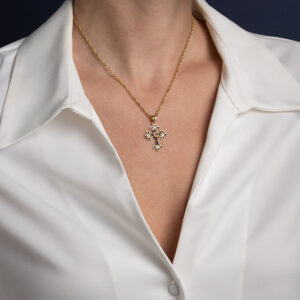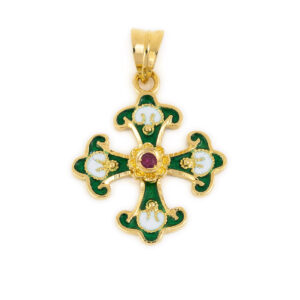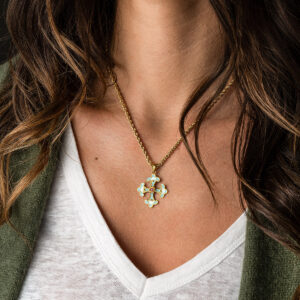18K Gold and Blue Enamel Byzantine Ruby Cross
546,00€Byzantine Cross is embellished with blue and white enamel, a rosette flower in the center which is decorated with a ruby and granules of precious metal.
The back side of the cross has not decoration. Available with turquoise enamel. Choose your preferred enamel color.
Handmade with the great attention to detail. Inspired by Byzantine art.
Made in 18k gold
Filigree is a delicate kind of jewellery metalwork, made with tiny beads or twisted threads, or both in combination, soldered together or to the surface of an object of the same metal and arranged in artistic motifs. The art of filigree dates back to ancient history. The first of the found jewelry in this technique have been found in Mesopotamia and dates to thousands of years BC. In the ancient world and particularly in Asia Minor, this art grew were at the highest level.
Granulation (from Latin: granum = “grain”) is a jewellery technique whereby a surface of a jewel is covered with small spheres or granules of precious metal. The technique is thought to have its origins in Mesopotamia about 5,000 years ago.
Rosette flower
The rosette (rose) is a timeless jewel, symbol and amulet. The origin of the term is the Greek word for rose – rodon (ρόδον). Its use began in the Mycenaean era and continues as far as the 2nd millennia BC. The Mycenaean Rosette is a motif that was widespread throughout Mesopotamia, Egypt, Greece and other ancient civilizations. It is inspired by a Mycenaean rosette bead, found at Mycenae, dated to 1400-1300 B.C. The rosette were used extensively in ancient Greek Mycenaean jewels, in architecture, pottery and in sculptures from 1500 BC. Mycenaean rosettes usually had 6 or 8 or 12 leaves, and sixteen leaves during the Macedonian Dynasty. Such details as the rodax shape and the number of leaves tend to vary with the era or beliefs. The rosettes were used to decorate the cloths, the belts and wreaths of the Kings. The number of leaves had a symbolic character each time. The four elements of nature (wind, earth, fire, water), the seven wonders of the ancient world or the twelve gods of ancient Greeks and the world domination and radiance of the Kings of Macedonia. They were signs of beauty, purity, eugenics, worship and power. Rosette or Rodax was probably the most popular and favorite decorative element in Mycenaean era, classical antiquity and Byzantine times.
As in all handmade items there may be small differences in weight and dimensions and this is what makes them unique and precious.
18K Gold and Turquoise Enamel Byzantine Ruby Cross
546,00€Byzantine Cross is embellished with turquoise and white enamel, a rosette flower in the center which is decorated with a ruby and granules of precious metal.
The back side of the cross has not decoration. Available with green enamel. Choose your preferred enamel color.
Handmade with the great attention to detail. Inspired by Byzantine art.
Made in 18k gold
Filigree is a delicate kind of jewellery metalwork, made with tiny beads or twisted threads, or both in combination, soldered together or to the surface of an object of the same metal and arranged in artistic motifs. The art of filigree dates back to ancient history. The first of the found jewelry in this technique have been found in Mesopotamia and dates to thousands of years BC. In the ancient world and particularly in Asia Minor, this art grew were at the highest level.
Granulation (from Latin: granum = “grain”) is a jewellery technique whereby a surface of a jewel is covered with small spheres or granules of precious metal. The technique is thought to have its origins in Mesopotamia about 5,000 years ago.
Rosette flower
The rosette (rose) is a timeless jewel, symbol and amulet. The origin of the term is the Greek word for rose – rodon (ρόδον). Its use began in the Mycenaean era and continues as far as the 2nd millennia BC. The Mycenaean Rosette is a motif that was widespread throughout Mesopotamia, Egypt, Greece and other ancient civilizations. It is inspired by a Mycenaean rosette bead, found at Mycenae, dated to 1400-1300 B.C. The rosette were used extensively in ancient Greek Mycenaean jewels, in architecture, pottery and in sculptures from 1500 BC. Mycenaean rosettes usually had 6 or 8 or 12 leaves, and sixteen leaves during the Macedonian Dynasty. Such details as the rodax shape and the number of leaves tend to vary with the era or beliefs. The rosettes were used to decorate the cloths, the belts and wreaths of the Kings. The number of leaves had a symbolic character each time. The four elements of nature (wind, earth, fire, water), the seven wonders of the ancient world or the twelve gods of ancient Greeks and the world domination and radiance of the Kings of Macedonia. They were signs of beauty, purity, eugenics, worship and power. Rosette or Rodax was probably the most popular and favorite decorative element in Mycenaean era, classical antiquity and Byzantine times.
Βυζαντινός Σταυρός με Ρουμπίνι – 18Κ Χρυσό
490,00€ – 1.070,00€Βυζαντινός Σταυρός στολισμένος με σμάλτο, λουλούδι ροζέτα στο κέντρο που είναι διακοσμημένο με ρουμπίνι και κόκκους πολύτιμου μετάλλου. Η πίσω πλευρά του σταυρού δεν έχει διακόσμηση.
Χειροποίητο με μεγάλη προσοχή στη λεπτομέρεια. Εμπνευσμένο από τη βυζαντινή τέχνη. Κατασκευασμένο από χρυσό 18 καρατίων.
Διατίθεται σε 4 χρώματα σμάλτου: Τυρκουάζ, Μπλε, Πράσινο, Κόκκινο Διατίθεται σε 3 μεγέθη: Small, Medium, Large
Η αλυσίδα που εμφανίζεται είναι η αλυσίδα χρυσού 14 καρατίων (δεν περιλαμβάνεται).
Το φιλιγκράν είναι ένα λεπτό είδος μεταλλικού κοσμήματος, κατασκευασμένο με μικροσκοπικές χάντρες ή στριμμένα νήματα, ή και τα δύο σε συνδυασμό, συγκολλημένα μεταξύ τους ή στην επιφάνεια ενός αντικειμένου από το ίδιο μέταλλο και διατεταγμένα σε καλλιτεχνικά μοτίβα. Η τέχνη του φιλιγκράν χρονολογείται από την αρχαία ιστορία. Το πρώτο από τα κοσμήματα που βρέθηκαν σε αυτή την τεχνική έχει βρεθεί στη Μεσοποταμία και χρονολογείται χιλιάδες χρόνια π.Χ. Στον αρχαίο κόσμο και ιδιαίτερα στη Μικρά Ασία, η τέχνη αυτή αναπτύχθηκε στο υψηλότερο επίπεδο. Η κοκκοποίηση (από τα λατινικά: granum = «κόκκος») είναι μια τεχνική κοσμήματος κατά την οποία μια επιφάνεια ενός κοσμήματος καλύπτεται με μικρές σφαίρες ή κόκκους πολύτιμου μετάλλου. Η τεχνική θεωρείται ότι έχει τις ρίζες της στη Μεσοποταμία πριν από περίπου 5.000 χρόνια. Λουλούδι ροζέτας Η ροζέτα (τριαντάφυλλο) είναι ένα διαχρονικό κόσμημα, σύμβολο και φυλαχτό. Η προέλευση του όρου είναι η ελληνική λέξη για το τριαντάφυλλο – ροδόν. Η χρήση του ξεκίνησε από τη μυκηναϊκή εποχή και συνεχίζεται μέχρι τη 2η χιλιετίες π.Χ. Η Μυκηναϊκή Ροζέτα είναι ένα μοτίβο που ήταν διαδεδομένο σε όλη τη Μεσοποταμία, την Αίγυπτο, την Ελλάδα και άλλους αρχαίους πολιτισμούς. Είναι εμπνευσμένο από μια μυκηναϊκή χάντρα ρόδακα, που βρέθηκε στις Μυκήνες, που χρονολογείται μεταξύ 1400-1300 π.Χ. Ο ρόδακας χρησιμοποιήθηκε εκτενώς στα αρχαία ελληνικά μυκηναϊκά κοσμήματα, στην αρχιτεκτονική, την κεραμική και στα γλυπτά από το 1500 π.Χ. Οι μυκηναϊκοί ρόδακες είχαν συνήθως 6 ή 8 ή 12 φύλλα και δεκαέξι φύλλα κατά τη Μακεδονική Δυναστεία. Λεπτομέρειες όπως το σχήμα rodax και ο αριθμός των φύλλων τείνουν να ποικίλλουν ανάλογα με την εποχή ή τις πεποιθήσεις. Οι ροζέτες χρησιμοποιήθηκαν για να διακοσμήσουν τα ρούχα, τις ζώνες και τα στεφάνια των Βασιλέων. Ο αριθμός των φύλλων είχε συμβολικό χαρακτήρα κάθε φορά. Τα τέσσερα στοιχεία της φύσης (άνεμος, γη, φωτιά, νερό), τα επτά θαύματα του αρχαίου κόσμου ή οι δώδεκα θεοί των αρχαίων Ελλήνων και η παγκόσμια κυριαρχία και ακτινοβολία των Βασιλέων της Μακεδονίας. Ήταν σημάδια ομορφιάς, αγνότητας, ευγονικής, λατρείας και δύναμης. Η ροζέτα ή Ροδάξ ήταν ίσως το πιο δημοφιλές και αγαπημένο διακοσμητικό στοιχείο στη μυκηναϊκή εποχή, την κλασική αρχαιότητα και τους βυζαντινούς χρόνους.







